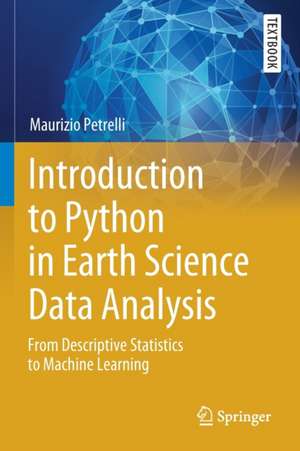Introduction to Python in Earth Science Data Analysis: From Descriptive Statistics to Machine Learning: Springer Textbooks in Earth Sciences, Geography and Environment
Autor Maurizio Petrellien Limba Engleză Paperback – 17 sep 2022
| Toate formatele și edițiile | Preț | Express |
|---|---|---|
| Paperback (1) | 361.70 lei 3-5 săpt. | +17.28 lei 4-10 zile |
| Springer International Publishing – 17 sep 2022 | 361.70 lei 3-5 săpt. | +17.28 lei 4-10 zile |
| Hardback (1) | 587.85 lei 6-8 săpt. | |
| Springer International Publishing – 17 sep 2021 | 587.85 lei 6-8 săpt. |
Din seria Springer Textbooks in Earth Sciences, Geography and Environment
- 15%
 Preț: 541.07 lei
Preț: 541.07 lei - 17%
 Preț: 464.86 lei
Preț: 464.86 lei - 17%
 Preț: 503.24 lei
Preț: 503.24 lei - 13%
 Preț: 358.05 lei
Preț: 358.05 lei - 15%
 Preț: 620.41 lei
Preț: 620.41 lei -
 Preț: 449.74 lei
Preț: 449.74 lei -
 Preț: 397.68 lei
Preț: 397.68 lei - 17%
 Preț: 463.56 lei
Preț: 463.56 lei -
 Preț: 508.54 lei
Preț: 508.54 lei -
 Preț: 512.38 lei
Preț: 512.38 lei - 17%
 Preț: 370.15 lei
Preț: 370.15 lei - 17%
 Preț: 528.27 lei
Preț: 528.27 lei - 17%
 Preț: 526.72 lei
Preț: 526.72 lei -
 Preț: 361.47 lei
Preț: 361.47 lei - 13%
 Preț: 459.27 lei
Preț: 459.27 lei -
 Preț: 367.41 lei
Preț: 367.41 lei - 15%
 Preț: 665.91 lei
Preț: 665.91 lei -
 Preț: 489.30 lei
Preț: 489.30 lei - 15%
 Preț: 706.16 lei
Preț: 706.16 lei - 19%
 Preț: 522.97 lei
Preț: 522.97 lei - 15%
 Preț: 714.81 lei
Preț: 714.81 lei -
 Preț: 453.42 lei
Preț: 453.42 lei - 19%
 Preț: 447.97 lei
Preț: 447.97 lei - 15%
 Preț: 590.63 lei
Preț: 590.63 lei - 15%
 Preț: 644.63 lei
Preț: 644.63 lei - 15%
 Preț: 721.37 lei
Preț: 721.37 lei - 23%
 Preț: 625.32 lei
Preț: 625.32 lei - 18%
 Preț: 751.29 lei
Preț: 751.29 lei - 19%
 Preț: 624.25 lei
Preț: 624.25 lei - 19%
 Preț: 578.98 lei
Preț: 578.98 lei - 15%
 Preț: 590.95 lei
Preț: 590.95 lei - 24%
 Preț: 1134.07 lei
Preț: 1134.07 lei - 19%
 Preț: 418.88 lei
Preț: 418.88 lei -
 Preț: 481.35 lei
Preț: 481.35 lei - 24%
 Preț: 684.57 lei
Preț: 684.57 lei - 15%
 Preț: 661.32 lei
Preț: 661.32 lei -
 Preț: 438.49 lei
Preț: 438.49 lei
Preț: 361.70 lei
Preț vechi: 435.79 lei
-17% Nou
Puncte Express: 543
Preț estimativ în valută:
69.22€ • 71.100$ • 57.15£
69.22€ • 71.100$ • 57.15£
Carte disponibilă
Livrare economică 25 martie-08 aprilie
Livrare express 08-14 martie pentru 27.27 lei
Preluare comenzi: 021 569.72.76
Specificații
ISBN-13: 9783030780579
ISBN-10: 3030780570
Pagini: 229
Ilustrații: XV, 229 p. 112 illus., 104 illus. in color.
Dimensiuni: 155 x 235 x 22 mm
Greutate: 0.35 kg
Ediția:1st ed. 2021
Editura: Springer International Publishing
Colecția Springer
Seria Springer Textbooks in Earth Sciences, Geography and Environment
Locul publicării:Cham, Switzerland
ISBN-10: 3030780570
Pagini: 229
Ilustrații: XV, 229 p. 112 illus., 104 illus. in color.
Dimensiuni: 155 x 235 x 22 mm
Greutate: 0.35 kg
Ediția:1st ed. 2021
Editura: Springer International Publishing
Colecția Springer
Seria Springer Textbooks in Earth Sciences, Geography and Environment
Locul publicării:Cham, Switzerland
Cuprins
Part I Python for Geologists, a kick-off.- Setting Up Your Python Environment, Easily.- Python Essentials for a Geologist.- Start Solving Geological Problems Using Python.- Part II Describing Geological Data.- Graphical Visualization of a Geological Dataset.- Descriptive Statistics.- Part III Integrals and Differential Equations in Geology.- Numerical Integration.- Ordinary Differential Equations (ODE).- Partial Differential Equations (PDE).- Part IV Probability Density Functions and Error Analysis.- Probability Density Functions and their Use in Geology.- Error Analysis.- Part V Robust Statistics and Machine Learning.- Introduction to Robust Statistics.- 12. Machine Learning.
Notă biografică
Maurizio Petrelli works as a researcher in petrology and volcanology at the Department of Physics and Geology, University of Perugia. In 2001, he graduated in Geology and obtained his PhD in February 2006 at the University of Perugia.
His current studies are focused on the petrological, volcanological and geochemical characterization of magmatic systems with particular emphasis on time-scales estimates of magmatic processes. He combines the use of numerical simulations, experimental petrology and the study of natural samples. Since 2016, he has developed a new line of research at the Department of Physics and Geology, University of Perugia focused on the application of Machine Learning techniques to petrological and volcanological studies.
Textul de pe ultima copertă
This textbook introduces the use of Python programming for exploring and modelling data in the field of Earth Sciences. It drives the reader from his very first steps with Python, like setting up the environment and starting writing the first lines of codes, to proficient use in visualizing, analyzing, and modelling data in the field of Earth Science. Each chapter contains explicative examples of code, and each script is commented in detail. The book is minded for very beginners in Python programming, and it can be used in teaching courses at master or PhD levels. Also, Early careers and experienced researchers who would like to start learning Python programming for the solution of geological problems will benefit the reading of the book.
Caracteristici
Numerous step-by-step code examples in the field of Earth Sciences Allows proficient use of Python in visualizing, analyzing, and modelling geological data Specifically minded for teaching Python to geologists
